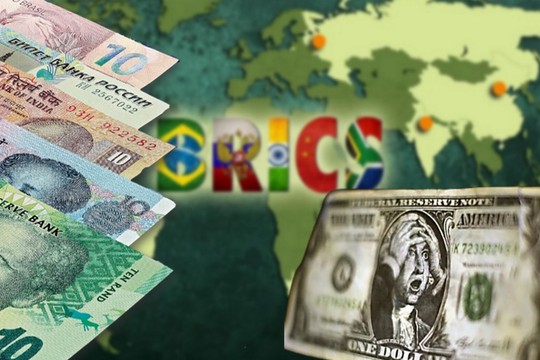“De-dollarizing” the world economy could have dangerous consequences for the United States. The BRICS alliance — originally comprising Brazil, Russia, India, China, and South Africa — took a major step toward flexing its communal currency muscle at its recent summit in South Africa, writes ‘The New York Post’.
Six new members joined the organization — Saudi Arabia, Iran, Ethiopia, Egypt, Argentina, and the United Arab Emirates — in an effort to reduce the dollar’s decades-long dominance and end its use as the preferred payment for the one commodity that still dominates global trade: oil.
The dollar’s role as the world’s key reserve currency is the foundation for America’s global leadership.
Most crucially, at a time of unprecedented global conflict, diminishing the dollar’s importance would allow rogue nations such as Iran and Russia to become immune to sanctions in response to geopolitical bad behavior.
Lower demand for the currency might make exports cheaper but it will also reduce the dollar’s purchasing power and undermine confidence in its stability.
As the BRICS summit made clear, the block’s leverage in the oil market has never been greater.
This has given them unprecedented power to finally replace the dollar on the global energy markets with their own domestic currencies.
Take a close look at the selective approach the alliance used to expand its membership.
While the bloc did not provide details about specific admissions criteria, the selection is clearly energy-centric.
Only six out of more than 40 applicant nations were accepted this year — with sizable economies such as Turkey and Indonesia conspicuously left out.
The anti-Western alliance now has six of the world’s top oil producers – Saudi Arabia, Russia, China, Brazil, Iran, and the United Arab Emirates.
It’s also home to two of the world’s largest oil importers – China and India.
Although 90% of oil trades are currently conducted in dollars, an increasing number are being handled in Chinese yuan and Russian rubles.
India, for instance, has started paying for Russian oil imports in yuan, and China also began using its yuan to pay Russia for most of its energy imports in the first quarter of this year, according to Reuters.
Saudi Arabia may be new to BRICS, but it’s already colluding with Russia to reduce petroleum production, which has resulted in oil reaching a 10-month high this month.
What’s notable about the BRICS newcomers is that many are authoritarian regimes who are intimately familiar with the power of US sanctions.
Iran, of course, has contended with them for years.
The Saudis — while a crucial US ally — are keen to avoid the “consequences” called for by Biden in October after OPEC+ announced those large production cuts.
Back in 2020, Biden also threatened to make the kingdom a “pariah” over the killing of the Saudi journalist Jamal Khashoggi.
By shutting Washington out of trade and diplomacy, BRICS membership allows rogue nations to upend our ability to “weaponize” the dollar as a tool to punish ‘bad guys’.
The US has employed sanctions for decades, in lieu of military intervention against authoritarian regimes such as Iran, North Korea, and now Russia.
The White House, for instance, seized $300 billion in Russian assets following its invasion of Ukraine.
Biden also removed Russia from SWIFT, the international money transfer system, sending shock-waves to non-western nations at risk of White House ire.
But sanctions, no matter how robust, have proven ineffective. China and India — both of which have yet to condemn Russia for its invasion of Ukraine — have kept Moscow’s energy revenue flowing, helping to finance Putin’s war machine and highlighting the power of BRICS cooperation.
The BRICS already have a significant presence across the global economy.
With a collective population of more than 3 billion and 31.5% of the world’s GDP, they’re a formidable challenger to the G7 block of the world’s top economic superpowers.
The G-7’s share of global GDP, for instance, is currently at 30%, and projected to fall to 27.95 percent in 2027, according to Statista research.
The dominance of the dollar has driven many non-Western nations to join forces and develop a counterweight to Western economic hegemony.
…The NYP says clearly, dollar will be “the currency for democracies.” It means that the United States is doomed to retreat under the growing pressure of BRICS+ and their new currencies. In any case, the West no longer can prevent the trend of de-dollarization.
read more in our Telegram-channel https://t.me/The_International_Affairs

 10:33 28.09.2023 •
10:33 28.09.2023 •























